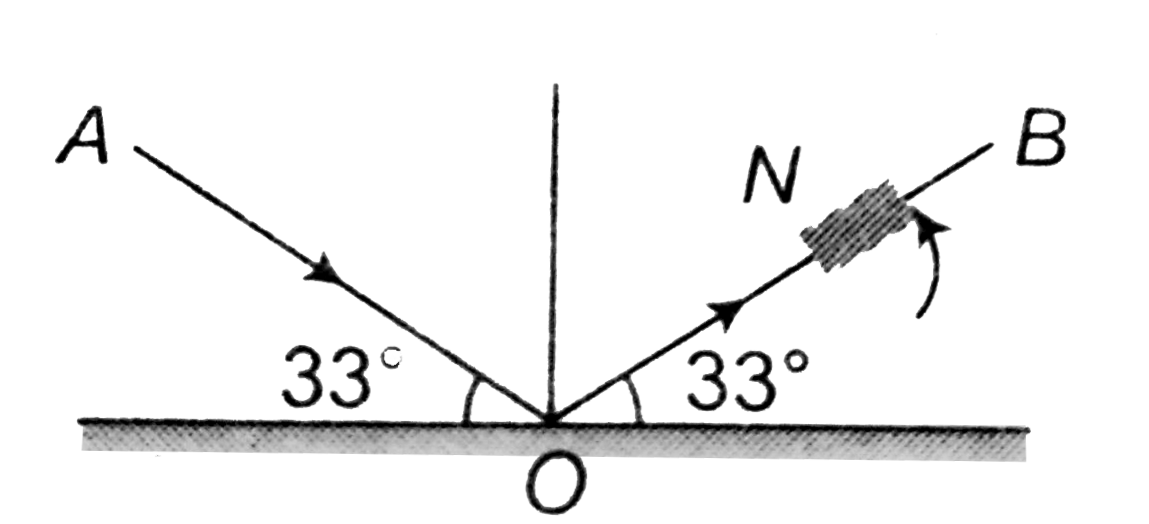A beam of light AO is incident on a glass slab (μ=1.54) in a direction as shown in the figure. The reflected ray OB is passed through a Nicol prism on viewing through a Nicol prism, we find on rotating the prism that

The intensity is reduced down to zero and remains zero
The intensity reduces down somewhat and rises again
There is no change in intensity
The intensity gradually reduces to zero and then again increases
The correct Answer is:D
In the arrangement shown, the unpolarised light is incident at polarising angle of 90∘−33∘=57∘. The reflected light is thus plane polarised light. When plane polarised light is passed through Nicol prism (a polariser or analyser), the intensity gradually reduces to zero and finally increases.
Similar Questions
A beam of light AO is incident on a glass slab (μ=1.54) in a direction as shown in the diagram The reflected ray OB is passed through a polaroid On viewing through the polaroid. We find that on rotating the polaroid (given tan57∘=1.54)
 View Solution
View SolutionA beam of light is incident on a glass slab (μ=1.54) in a direction as shown in the figure. The reflected light is analysed by a polaroid prism. On rotating the polaroid, (tan57∘=1.54)
 View Solution
View Solution
Knowledge Check
- Question 1 - Select One
A beam of light AO is incident on a glass slab (μ=1.54) in a direction as shown in figure. The reflected ray OB is passed throught a Nicol prism. On viewinf through a Nicole prism, we find rotating the prism that (tan−11.54=57∘)
 Athe intensity is reduced down to zero and remains zeroBthe intensity reduces down some what and rises againCthere is no change in intensityDthe intensity gradually reduces to zero and then again increases
Athe intensity is reduced down to zero and remains zeroBthe intensity reduces down some what and rises againCthere is no change in intensityDthe intensity gradually reduces to zero and then again increases - Question 2 - Select One
A beam of light AO is incident a glass slab (μ=1.54) in the direction show. The reflected ray OB is passed through a Nicol prism. On viewing through a Nicol prism, we find on rotating the prism that
 Athe intensity is reduceed down to zero and remains zeroBthe intensity reducees down somewhat and rises againCthere is no change in intensityDthe intensity gradually reduces to zero and then again increases
Athe intensity is reduceed down to zero and remains zeroBthe intensity reducees down somewhat and rises againCthere is no change in intensityDthe intensity gradually reduces to zero and then again increases - Question 3 - Select One
When white light passes through a glass prism
Ared coloured ray undergoes maximum deviation.Bgreen coloured ray undergoes minimum deviation.Cblue coloured ray undergoes minimum deviation.Dviolet coloured ray undergoes maximum deviation.
A beam of light is incident on a glass slab (μ=1.54) in a direction as shown in the figure. The reflected light is analysed by a polaroid prism. On rotating the polaroid, (tan57∘=1.54)
(##DPP_PHY_CP24_E01_002_Q01.png" width="80%">View SolutionA beam of light incident on a glass slab (μ=1.54) in a direction as shown in the figure. The reflected light is analysed by a polarioid prism, On rotating the polariod, (tan57∘=1.54)
 View Solution
View SolutionA light beam is incident on a rectangular glass plate (μ=1.54) The reflected light OB passes through a nicol prism.
On observing the transmitted light while rotating the prism, it is seen that
 View Solution
View SolutionWhen a ray of light passes through glass slab, refraction of light occurs___
View SolutionWhen a ray of light passes through a prism,
View Solution

